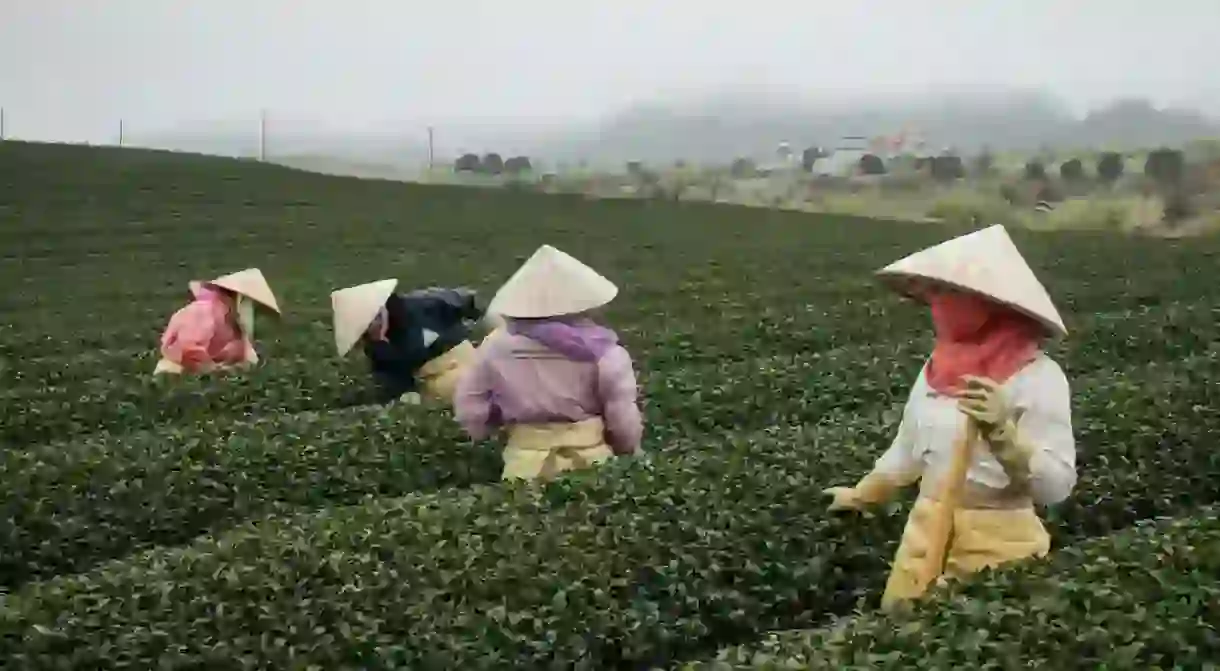A Day at The Moc Chau Tea Plantations, Vietnam

Moc Chau is a large, mountainous district of Son La Province, about 125 miles (200 kilometers) west of Hanoi. It makes for a great intermediate stop between Hanoi and Mai Chau, a popular tourist destination that is similar to Sapa.
Moc Chau is at an altitude of 3,460 feet (1,054 meters) above sea level and has a temperate climate with the average temperatures being a cool 60–79°F (15–26°C). It’s one of the biggest plateaus in the country, stretching some 50 miles (80 kilometers) long and 16 miles (25 kilometers) wide. Thanks to the cool climate, it’s home to about 3,000 hectares of tea gardens.

It looks a little as if an artist has painted the region in a beautiful shade of dark green. There are many large tea farms and some of the most popular ones are in Nong Truong, Moc Chau Town, and Tan Lap Commune. These vast green tea plantations stretch as far as the eye can see, spreading over many rolling hills. They are similar to those found in the Central Highland province of Lam Dong.

During springtime, it’s a tea tree celebration! The plateau will welcome you with a mild climate, and perhaps even rain. A refreshing breeze always brushes through the slopes of the plateaus during this time, and the rustle of the tea leaves is a peaceful background noise.

The area is inhabited by people of different ethnic minorities, the predominant group being the Hmong, just like in Sapa. Other minorities are Dao, Kho Mu, and La Ha Tay. You can distinguish these tribes of people from one another, based on the colors and styles of their tribal outfits.

Moc Chau is a significant producer of high-quality tea. Among the types produced here, you can find Oolong, Kim Tuyen, and Shan Tuyet. Shan Tuyet was the first to be planted here, some 50 years ago, and it’s grown on the greater part of the plateau. The different varieties of tea are also processed differently.

The tea trees found here can be dozens of years old and generally, the older ones produce the best quality leaves. If tea plants are left undisturbed, they can grow up to 52 feet (16 meters) in height. They are trimmed to waist levels for ease of plucking.
Harvest season is from April to December, spanning a period of nine months. The common belief is that tea leaves plucked in April produce the best tasting tea, as they are the first leaves to be extracted after a four-month period of rest. The best time of day to pick leaves is considered to be from 9:00 a.m. to 3:00 p.m.




This is Mrs. Tan. Tending to the tea plants is a part of her daily life. Mrs. Tan is from the Thai minority in Moc Chau. She is only 31 years young, and has two kids, with another baby coming soon. She talks lovingly about her work, as if the tea plants are her children too, even if she’s only been working at the plantation for just over a year. Just know that the cup of tea you may be having right now is made with love and care.


You can take tours of the tea plantations. Visitors are given the chance to get up close and personal with the locals in the field, like Mrs. Tan. You even get to work with the locals in the fields and pick the leaves and buds (technically known as flushes). It will be a huge learning opportunity, as you get to interact with the workers that care for the plantations daily. They put a lot of love into their work, so be wary of damaging the plants when you get to help out.


After working in the fields, you can process your buds in a processing warehouse. At the warehouse, you will dry and ferment the tea leaves. Afterwards, they are rolled and vacuum-packed. It’s something you cannot learn from a book.
At the end of the day, you can even enjoy a warm cup of tea that you have helped to process, while you breathe in the aroma of the plants and listen to the rustle of the leaves in the breeze. If you are interested in booking a tour, look at Moc Suong Tea Company in Tan Lap Commune, a private enterprise that only recently began offering tours to visitors.

To get to Moc Chau from Hanoi, you can take the bus. Buses depart regularly from the Yen Nghia and My Dinh bus stations in Hanoi. You can also take a bus from Hanoi to Mai Chau which is another 37 miles (60 kilometers) from Moc Chau. Mai Chau is a great place to stay at for the night, in a homestay. From Mai Chau to Moc Chau, there are many buses, or you can rent a motorbike for the day and head to the tea plantations by yourself. It’s a nice, easy, and scenic route. Other places to visit in Moc Chau include the pine forest in Ang Village, Dai Yem and Chieng Khoa waterfalls, Pa Phach Village, Doi (or “bat”) Cave, the Love Market, and Pha Luong Mountain.













